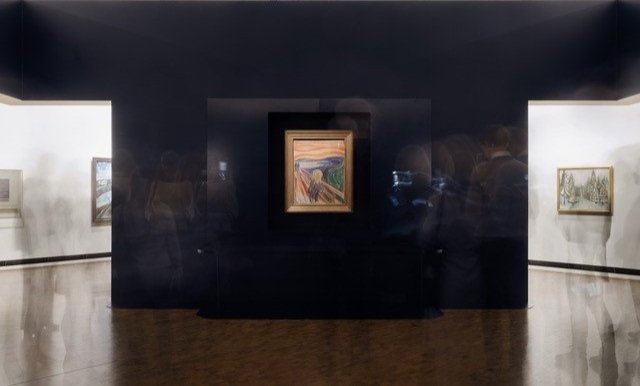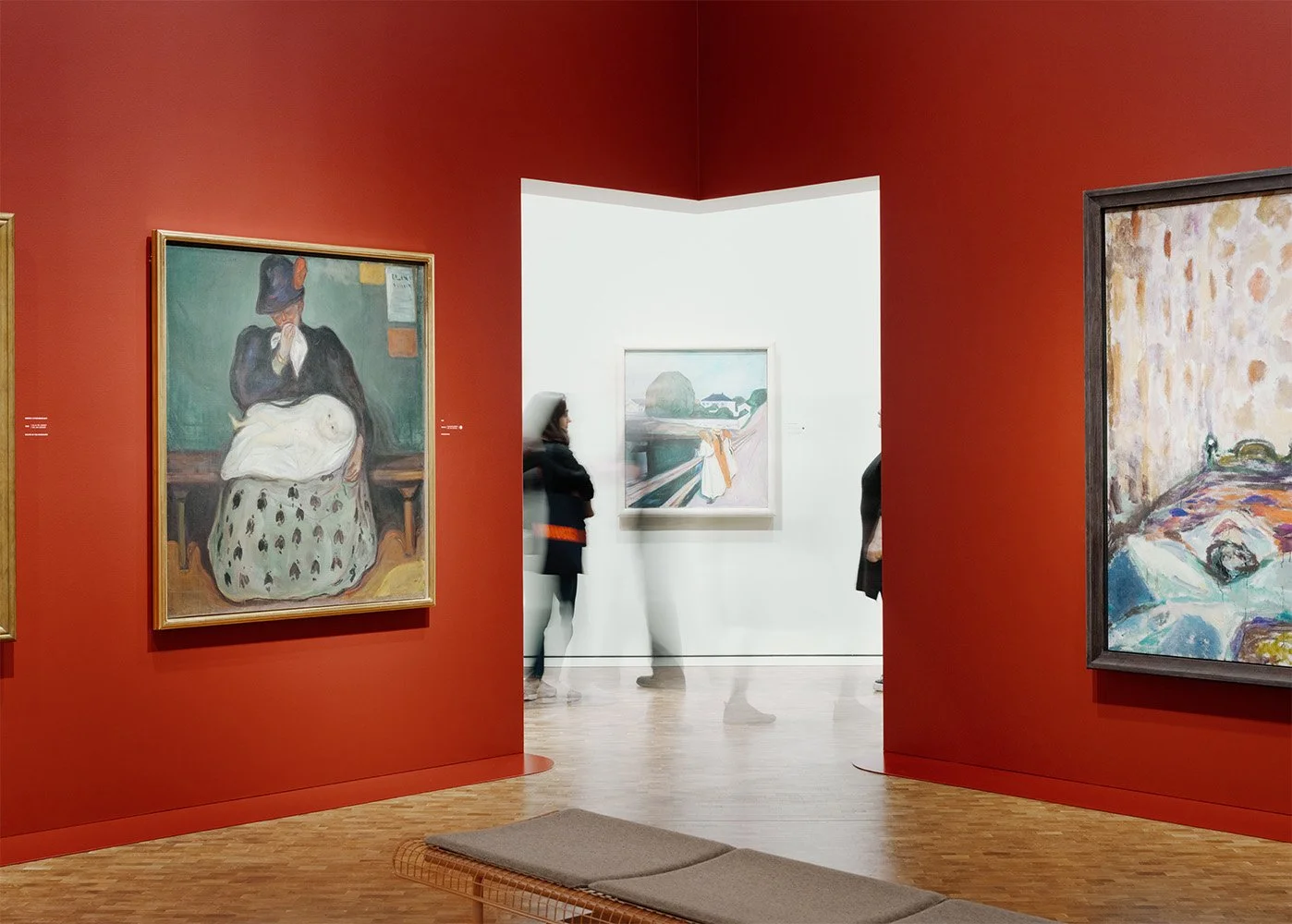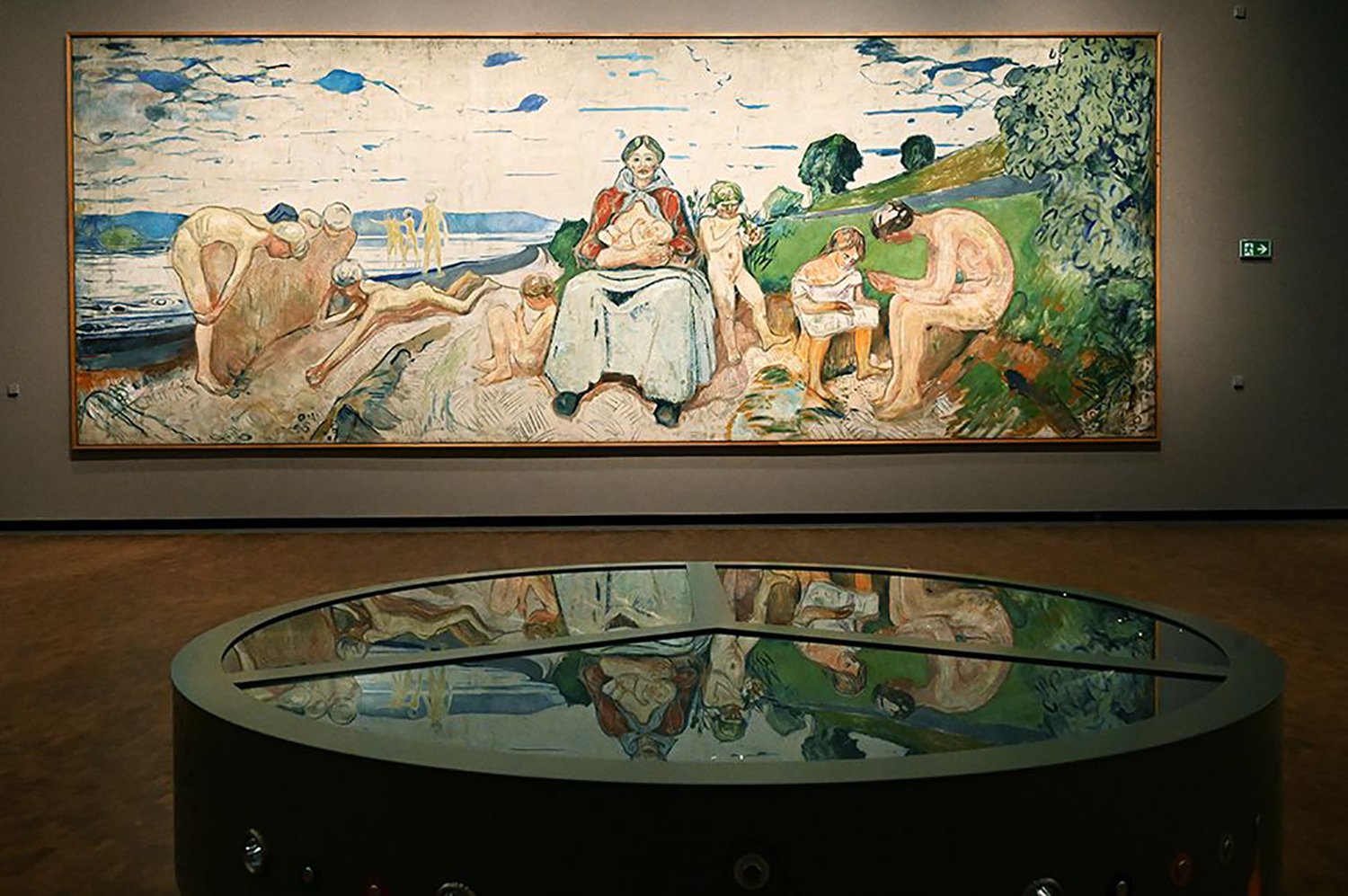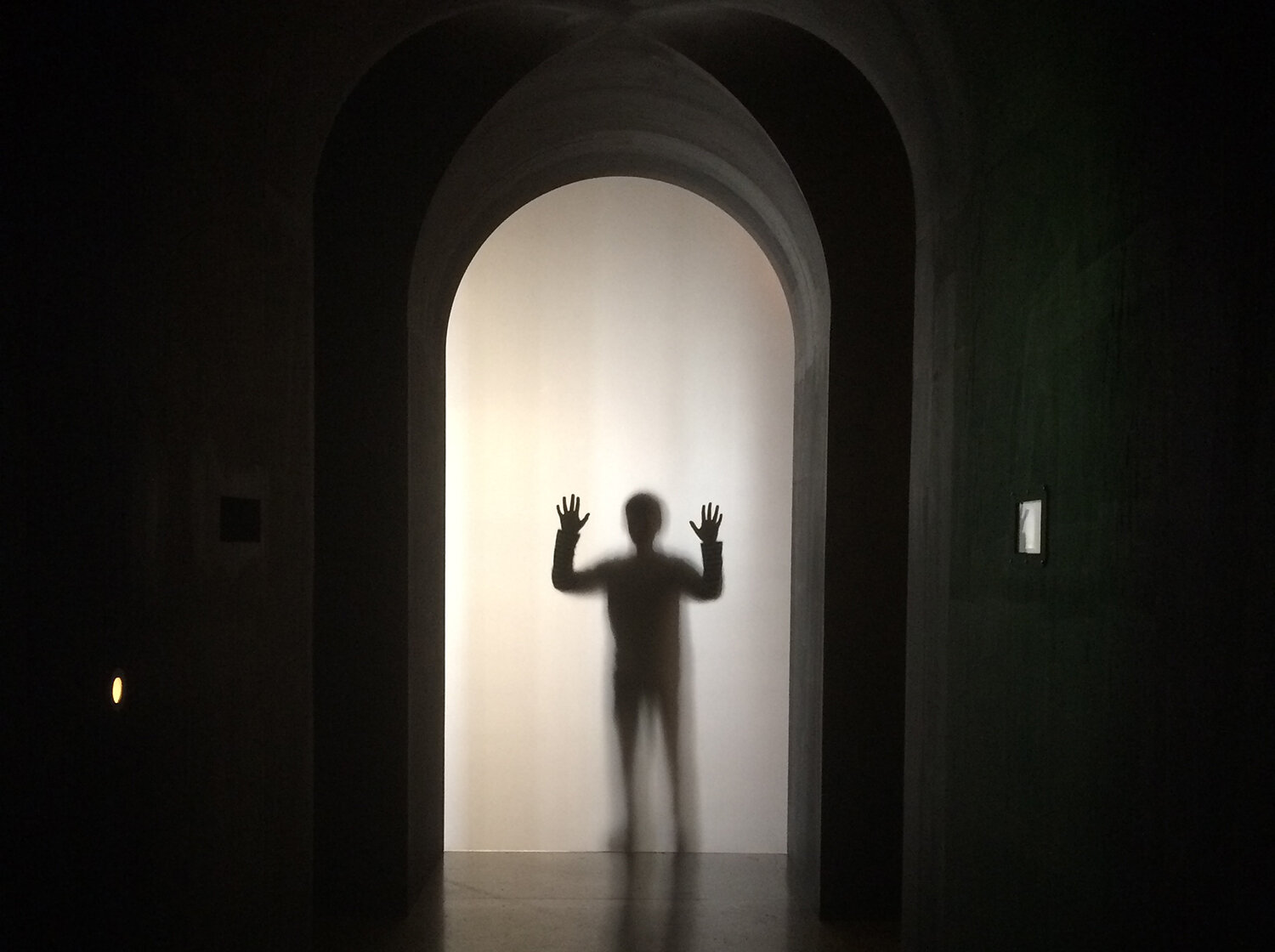Brunnsparken coffeshop
Gothenburg, Sweden
Location: Gothenburg, Sweden
Year: 2022
Status: Open competition, third prize
Photo Credit: manthey kula
A small kiosk: prefabricated modules clad in copper and green concrete elements.
Flåm restaurant and foodcourt
Flåm, Norway
Location: Flåm, Norway
Year: 2019
Status: Invited Competition
Photo Credit: manthey kula
A glue-lam post and beam structure clad in raw aluminium housing restaurants and food market in the heavily touristed village of Flåm in the fjord landscape of western Norway.
Innisfree
Sligo, Ireland
Year: 2015
Status: Competition
Open competition for an installation celebrating William Butler Yeats 150 years anniversary
What to protect? That which is still untouched and that which we long for
What to give? A specific place with a universal resonance
A highly polished stainless steel surface onto which a sculptural, yet functional steel chair is welded. Mounted on pontoons dimensioned to support the platform right above the water level.
In due time the steel floor will be transported to its final position at the university campus where the chair will continue to support lingering dreams.
Landscape of the future
Copenhagen, Denmark
Year: 2020
Status: Paper work made for the celebration of the 100 years anniversary of LANDSKAB, the Danish Landscape architect’s magazine.
Photo Credit: manthey kula
Landscape means an area, as people perceive it, whose distinctive character is the result of the influence of and interaction between natural and/or human factors.* The title Landscape of the future calls for speculation about the balance between the natural and the man-made. Our contribution shows a series of constructed landscape images. The landscape images are based on structures and formations found in the 40 landlocked national parks in Norway.
*Landscape - Terms and definitions, Directorate for Nature Management, 2012
Postludes
London, UK
Year: 2020
Status: Paper work exhibitied at Betts Project, London, United Kingdom
Photo Credit: Betts Project and manthey kula
The exhibition Postludes takes its title from the last and conclusive element one might add to a construction, and draws attention to the nature and post-potential of architectural drawing.
The works found in Postludes operate as creative endeavour to afix a new and conclusive stage to a design process. Each work departs from one of manthey kula’s ongoing or completed projects from the last ten years. Instead of facilitating a schematic representaiton of the project, this new stage takes a more expressive exploration into form and architecture. The variously coloured papers are delicately cut, juxtaposed and layered, creating motives that deviate from their original plans yet hint at architectural features such as railing elements, gutter holes, ramps, elevations, walkways or columns. This process of cutting and further abstracting architectural forms and functions can be seen as methods of freeing content from their original meanings and reappointing it to new systems of architectural awareness, thereby unveiling new narratives and posing new enquiries into the possibilities of architectural drawing.
Archipelago – Building from solitude
Val de Loire, France
Year: 2017
Status: Part of the collection at the Frac Centre Val de Loire, France
Photo Credit: manthey kula
Archipelago - Building from solitude is a work commissioned by Le Frac Centre, Val de Loire. The five projects are generated from brief accounts of five individuals that experienced profound isolation, across history and across the map. The fates of these people are known. However, their dreams – products of lived impressions, existential reasoning, and subdued thoughts – remain outside our reach. In the five projects exact formal and spatial ideas are developed from speculation and inspiration. As such the work explores the relationship between order, association and intuition.
Other house
Rome, Italy
Year: 2016
Status: Paper Project, exhibitied at CAMPO gallery in Rome, FRAC Centre-Val de Loire and at Budsjord pilegrimsgård
manthey kula was given a framework of a human emotion: hope, and an architectural principle: system. These two concepts were to be used as lenses to reflect upon two images by Walter Pichler from the FRAC archive of experimental architecture.
One structure, two inhabitants, one building, two territories, one nature.
The life in the house is told from A – Y.
Z is another story.
Window
Distant silence from the empty house below,
Rising to the rituals of the body, shedding warmth of sleep in front of glass.
Night is leaving, day is coming slow,
Cold feet on the floor while I watch the morning pass.
Early light across the curving wall, pointing to an aim.
Sudden movement, modest glimpses, all concluded in mutual recognition:
Rounded shoulder, naked neckline and the features of another face.
Thinking: Should I think of him by name?
Constant concrete framing figures fixed in opposition,
Projected longing to a shared horizon, nestled in between suspended space.
Table
Descending slowly into waves of light.
Where a solid echo protects the attributes of home.
Context – wild and tended – emerging into sight,
Reflected sun draws maps for eyes that roam.
Steel and concrete positioned with decision,
Fulfilled geometries eclipse the other life.
Sharing structure: are we seated at a common table?
Domesticity unfolds inside precision,
Space divides existences like a knife.
Our presences in orbit are not stable.
Fire
Expansion turning to contraction till the skin is circumscribed by wall,
Horizontal light moves inwards, finding refuge in a darkened apse.
Enclosed by cast construction, the threshold to the world is tall,
Your heat transported through the structure; a momentary lapse.
Balanced span and optimistic tension,
Support the sturdy slab and tender use,
Solitary flames uphold the common mound.
Inside a rare dimension,
Space is tight, but time is loose.
Looking outside to the outside ground.
Mirror
Rapid run to a common point,
Where independent systems meet and measure.
Separated and connected in a membrane joint,
Reflected eyes give pleasure.
Trembling surface, resonating footsteps in a stair,
My image in the mirror standing still:
Will you feel my presence when you pass?
Sudden shivers and a scent of moss is brought by air,
Silence kept by doubt and not by will.
Cyclic life is calling through the glass.
Forest
The house is left behind for open sky.
Beneath the feet a certain softness of the earth,
Myriads of nuances hit the eye:
Living matter reminiscent of birth.
Where you are enters my concern,
As I pass through heel high heather.
The ground is changing to a gentle slope.
I seek the forest in order to return,
Trunks and branches twined together.
This community of beings gives us hope.
Tribunal for the displaced
Venice, Italy
Year: 2012
Status: Paper Project, exhibitied in Venice, Italy
Photo Credit: manthey kula
The tribunal gives architectural substance to questions concerning the individual and the collective, freedom and totalitarianism, silence and speech.
The project examines the possibility for a new social and architectural program based on interpretation of a contemporary global situation. It suggests a shift of questions concerning residency for migrants away from the national economic realm to the common ground of humanity. The tribunal is an institution based on the constant laws of compassion rather than on the ever-changing political agendas and bureaucracies. It is one of several courts that are established in regions of migration. An international body of justice administers these courts.
The displaced is whoever seeks legal residence, be it a refugee or a paperless immigrant. The objective of the tribunal is to decide whether the permit should be granted. The displaced testifies to a jury of six laymen, one from each continent appointed for a month-long service by the international administrative body. The assessment of each testimony is based solely on the jury’s opinion of the story of the displaced. If the permit is granted it is immediately produced and the migrant can leave the tribunal as a resident. If the jury is not convinced by the testimony he or she must return.
Each testimony and each jury decision is documented and archived. The archive of the tribunal will become a source to the understanding of a global situation and of the human heart.
The tribunal is situated in Cannaregio at the end of Calle de la Beccarie, overlooking Ponte Della Libertá.
THE DISPLACED
Each morning a group of displaced arrive at the dock by boat from a center on the mainland. The group ascends to the third floor where they await their turn to testify. The time spent in the tribunal waiting is stressful to most of the migrants. The secretary accompanies each migrant to the tribunal on the fourth floor. The hearing usually takes less than two hours, some times more. The desicion of the jury is given without disussion among its members. As such, every desicion is an individual concern for each memnber of the jury. If the jury finds the migrant’s testimony convincing, a residence permit is produced immediately by the notary. After having received the permit the new citicen leaves the tribunal, entering the city through the square in front of the building. At the end of the day the refused, if any , are transported back to the main land, later to return to their native contries.
THE PUBLIC
The hearings are open to the public. Sixty seats in the tribunal are intended for citizens, relatives, journalists, students and researchers. However, no interference of the testimonies is allowed. Apart from the voice of the migrant, and some muffled sound when the hands of the jury are shown after the testimony is over, the tribunal is very quiet. The square outside the tribunal is busy with people: the air is filled with anticipation and exclamations of joy and relief. Only seldom are there outbursts of anger or silent grief.
THE JURY
The jury consists of six laypeople, one from each continent. They are appointed for a month’s service by the international administrative body. Their assignment is to decide whether the displaced should be granted residency based on her or his testimony. The decision of the jury is a majority desicion where at least five of its members have to agree on the outcome. Each case is set without discussion. While in Venice, the six jurors stay in the quarters on the second floor of the tribunal building, where the meals are prepared and served by the caretakers. In the evening the jury members gather in the parlour or on the terrace to recapitulate the testimonies of the day.
THE SECRETARY
The secretary of the tribunal must speak Italian, English, Spanish and Chinese fluently. It is the secretary’s duty to facilitate the hearing procedures, set the schedules, inform each jury and the public of routines and requirements, arrange for qualified interpreters to be present when needed, and transcribe every testimony for archival purposes. The secretary is not expected to stay on for more than two years.
THE INTERPRETERS
Interpreters of Venice are summoned to the tribunal when their service is needed. In order to qualify one has to sign a non-disclosure agreement. The number of interpreters present each day depends on the origin of the migrants and the composition of the jury. The scheduling of the interpreters is organized by the secretary.
THE NOTARY
The notary is an official clerk whose role is to issue legally correct residency permits to those migrants accepted by the jury. The notary does not engage in the drama of the tribunal. While the displaced give their testimonies the notary arranges the documents and the legal stamps on the desk according to height, size and number.
THE CARETAKERS
The caretakers, a former migrant couple, maintain the daily routines in the building. They prepare meals for the displaced and look after the jury quarters and the waiting rooms. From their flat on the first floor they can reach all parts of the building. They are the only ones that have access to the stairway of the displaced.
THE ARCHIVIST
Every morning the archivist receives a file from the secretary where the testimonies of the day before are transcribed to English, Chinese and Spanish. The testimonies are archived according to date, country of origin and category. The largest categories in the archive are: war, persecution, famine, and hope. When the archivist is not filing or finding testimonies for citizens, journalists, relatives, researchers and students, he sits in his office trying to fathom the existential consequences of the outcome of the ongoing hearings.
Virginia
Oslo, Norway
Year: 1997-2001
Status: Paper Projects
Photo Credit: manthey kula
Aknowledgement: The Virginia project is part of the collection of the National museum, Norway
The Virginia Series consists of four projects based on female literary characters. The projects have been exhibited at the Finnish museum of architecture in Helsinki, Galleri Rom, Oslo, The Artists Association, Baku, Pilegrimsgården Budsjord, Dovre and the National museum, Oslo.
Compassion in Action
Nobel Peace Center, Oslo, Norway
Location: Nobel Peace Center, Oslo, Norway
Year: 2022
Status: Built
Client: Nobel Peace Center
Photo Credit: Nobel Peace Center/ Johannes Granseth
An anniversary exhibition celebrating Fridtjof Nansen’s work leading up to him receiving the Nobel Peace Prize in 1922. The exhibition focuses on Nansen’s humanitarian legacy by showing some of the recipients of the UNHCR Nansen Award.
Satyricon & Munch
MUNCH, Oslo, Norway
Location: The Munch museum, Oslo, Norway
Year: 2022
Status: Built
Client: The Munch museum
Photo Credit: The Munch museum and Peter Geelmuyden Magnus
An exhibition presenting work by Norwegian black metal band Satyricon and Edvard Munch. The meeting between Satyricon’s commisioned composition and a selection of paintings and graphics by Munch resulted in a monumental and at the same time intimate experience that captured all senses.
Collection exhibitions at the new Munch museum
MUNCH, Oslo, Norway
Location: The Munch museum, Oslo, Norway
Year: 2021
Status: Built
Client: The Munch museum
Photo Credit: The Munch museum/ Einar Aslaksen and Manthey Kula
In the new Munch museum by estudio Herreros there are four collection exhibitions designed by Manthey Kula:
Edvard Munch : Infinite is a large exhibition showing paintings, print-works, drawings and bronze sculptures by Munch. The open plan emphasizes the non-linear presentation of the art works.
Edvard Munch : Monumental shows some of Munch’s monumental paintings including sketches and a draft for a sculpture.
Up Close is an intimate exhibition showing a selection of Munch’s print-works and printing blocks.
Edvard Munch : Stenersen shows works from the collection of Rolf Stenersen, a contemporary art collector and friend of Edvard Munch.
The exhibition halls have two to four entrances and no daylight. Manthey Kula is responsible for the spatial layout of the exhibitions, design of walls, colors, display cases and safety measures.
Zenisk as is responsible for the lighting design. Blæst Design as is responsible for the graphic design.
Interactive elements at the new Munch museum
MUNCH, Oslo, Norway
Location: The Munch museum, Oslo, Norway
Year: 2021
Status: Built
Client: The Munch museum
Photo Credit: The Munch museum/ Einar Aslaksen and Manthey Kula
Manthey Kula has conceived and designed several interactive elements for the collection exhibition. Hidden peep-holes where children can explore scenes connected to the themes of Edvard Munch. A large interactive table where children can discover and investigate objects from nature that are linked to the work and art of Edvard Munch and table where the public can test the frottage-technique.
The steel structure of Munch University is produced by Eskil Tin as. Concept Design has been lighting consultants.
Looking Through Portals
Museum of Cultural History, Olso, Norway
Location: Museum of Cultural History
Year: 2018
Status: Built
Client: Museum of Cultural History
Photo Credit: manthey kula
With Eyes Closed - Gauguin and Munch
The Munch museum, Oslo, Norway
Location: Munch museum, Oslo
Year: 2018
Status: Built
Client: The Munch museum
Photo Credit: The Munch museum/ Ove Kvavik
Exhibition of art by Paul Gauguin (1848–1903) and Edvard Munch (1863–1944), two artists who in all likelihood never met. Gauguin is said to have remarked that he closed his eyes in order to see, while Munch famously said: “I don’t paint what I see, but what I saw.” The exhibition focused on the graphic work of the two aritist, revolving around three main suites made by Gauguin, exhibited in three unique spaces.
Det Felles Eide
Kunstnernes Hus, Oslo, Norway
Location: Kunstnernes Hus
Year: 2018
Status: Built
Client: Oslo Kommune
Photo Credit: Werner Zellien and manthey kula
Exhibition of a selection of Oslo municipalities’ art collection which consists of more than 20 000 works. This is art we all own, art we meet in the public space, art we relate to in our lives in the city.
Through Nature
The Munch museum, Oslo, Norway
Location: The Munch museum, Oslo, Norway
Year: 2014
Status: Built
Client: The Munch museum
Photo Credit: manthey kula
The exhibition was a collaboration between the Museum of natural history and the Munch museum, contextualizing Edvard Munch’s interest in the natural sciences by juxtaposing Munch’s art with objects from the zoological, botanical and geological collections.
Puberty
The Munch museum, Oslo, Norway
Location: The Munch museum, Oslo, Norway
Year: 2012
Status: Built
Client: Munch museum
Photo Credit: manthey kula
Mono exhibition of Edvard Munch’s newly restored painting Puberty at the Munch museum.
Prefabricated plywood panels and white flooring creating a space where the spectator is confronted with the vulnerability of both the young model and the painting.


























































































































